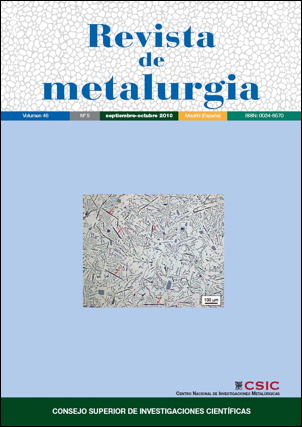Physical modeling of the impingement of an air jet on a water surface
DOI:
https://doi.org/10.3989/revmetalm.0954Keywords:
Physical modeling, Fluid flow, Gas jet, Free surface, Particle image velocimetryAbstract
The use of gas jets (oxygen) plays a key role in several steelmaking processes as in the Basic Oxygen Furnace (BOF) or in the Electric Arc Furnace (EAF). Those jets improve heat, mass and momentum transfer in the liquid metal, mixing of chemical species enhancing and govern the formation of foaming slag. In this work experimental measurements were performed to determine the dimensions of the cavity formed at the liquid free surface caused by a gas jet impinging on it; also velocities vectors were measured in the zone affected by the gas jet. Cavities were measured from images from high speed camera and the vector maps were obtained with a Particle Image Velocimetry (PIV) technique. Both velocities and cavities were determined as a function of the main process variables: gas flow rate, distance of the nozzle from the free surface and lance angle. Cavity dimensions were statistically processed treated as a function of the process variables and also as a function of the proper dimensionless numbers that govern these phenomena. It was found thatWeber and Froude numbers govern the cavity geometry. Liquid flow driven by the jet is mainly affected by the air flow rate, lance height and angle.
Downloads
References
[1] D. H. Wakelin, Tesis doctoral, University of London, 1966.
[2] M. Lee, V. Whitney and N. Molloy: Scand. J. Metall. 30 (2001) 330-336. doi:10.1034/j.1600-0692.2001.300509.x
[3] S. K. Sharma, J. W. Hlinka and D. W. Kern, Ironmak. Steelmak. 4 (1977) 7-18.
[4] A. Nordqist, N. Kumbhat, L. Jonsson and P. Jonssön, Steel Res. 77 (2006) 82-90.
[5] S. C. Koria and K. W. Lange, Steel Res. 58-9 (1987) 421-426.
[6] F. Qian, R. Muthasaran and B. Farouk: Metall. Mat. Trans. B 27 (1996) 911-920. doi:10.1007/s11663-996-0004-0
[7] G.A. Subagyo, K. S. Brooks, Coley, G.A. Irons, ISIJ Int. 43 (2003) 983-989. doi:10.2355/isijinternational.43.983
[8] F. Memoli, C. Mapelli, P. Ravanelli, M. Corbella, ISIJ Int. 44 (2004) 1.342-1.349.
[9] A. R. N. Meidani, M. Isac, A. Richardson, A. Cameron and R. I. L. Guthrie: ISIJ Int. 44 (2004) 1639-1645. doi:10.2355/isijinternational.44.1639
[10] Y. Tago and Y. Higuchi, ISIJ Int. 43 (2003) 209-215. doi:10.2355/isijinternational.43.209
[11] L. Gu, G. Irons, Electric Furnace Conf. Proc. 1999, pp. 269-278.
[12] M. P. Schwarz, Fluid Flow Phenomena in Metals Processing, The Minerals, Metals & Materials Society, 1999, pp. 171-178.
[13] K. D. Peaslee, D. G. C. Robertson, The Minerals, Metals & Materials Society. EPD Congress, 1994.
[14] R. B. Banks, D. V. Chandrasekhara, J. Fluid Mech. 15 (1963) 13-34. doi:10.1017/S0022112063000021
[15] P. Mc Gee, G. A.Irons, Electric Furnace Conf. Proc., 1999, pp. 439-446.
[16] J., Szekely, Fenómenos de flujo de fluídos en el procesamiento de metales., 1ª. Edición, Editorial Limusa, México, 1988, pp. 423-424.
Downloads
Published
How to Cite
Issue
Section
License
Copyright (c) 2010 Consejo Superior de Investigaciones Científicas (CSIC)

This work is licensed under a Creative Commons Attribution 4.0 International License.
© CSIC. Manuscripts published in both the printed and online versions of this Journal are the property of Consejo Superior de Investigaciones Científicas, and quoting this source is a requirement for any partial or full reproduction.
All contents of this electronic edition, except where otherwise noted, are distributed under a “Creative Commons Attribution 4.0 International” (CC BY 4.0) License. You may read the basic information and the legal text of the license. The indication of the CC BY 4.0 License must be expressly stated in this way when necessary.
Self-archiving in repositories, personal webpages or similar, of any version other than the published by the Editor, is not allowed.
















